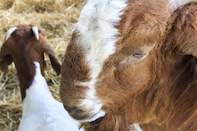
Boar goats are indigenous to South Africa. They originated from goats that made their way from Europe, India, Egypt and the Nubia to South Africa along the west and east coasts, and have been farmed with here for meat and milk for hundreds of years.
The initial stock consisted of a big jumble of animals, coming in all shapes, sizes and colours. Jeremias Treigaardt of the farm Van Wyksvlei near Bedford, and the Jordaans, Nells, Schoemans, Bothas and Krugers from Somerset East are regarded as the pioneers in the refinement of the Boer goat. The name Boer goat was chosen for the refined animal, because it was a goat with which farmers wanted to farm commercially. (The Afrikaans word for “farm” is “boer”.)
About a decade before the SA Boer Goat Breeders’ Association was founded, at a time when almost everybody owned a couple of goats, Theunis Jordaan already had a herd of 400 ewes – all white with red heads and well built. At one point, he allegedly sourced eight big framed Boer goats all the way from Frasersburg to Loxton, which he transported back to the farm via rail.
His Buffelsfontein Boer Goat Stud was the first to be registered. The stud was founded in 1931 when he purchased a ram from Triegaardt and half of the boer goats that belonged to the partnership of WG Jordaan and Sons, of which he was a partner. WG Jordaan, his father, bought two other rams from Triegaard that also played an important role in the transformation of the herd.
Botha published an information piece “Improving the boer goat Breed” back in 1943 already. He described the requirements to achieve greater consistency in the breeding of the desired type of boer goat, and in consultation with Jordaan, developed a point scale to help farmers with the selection of breeding animals. He was the first person to refer to the idea of a refined boer goat in 1950.
 South Africa is a relatively minor goat producing country, possessing approximately 3% of Africa’s goats and less than 1% of the world’s...
South Africa is a relatively minor goat producing country, possessing approximately 3% of Africa’s goats and less than 1% of the world’s...